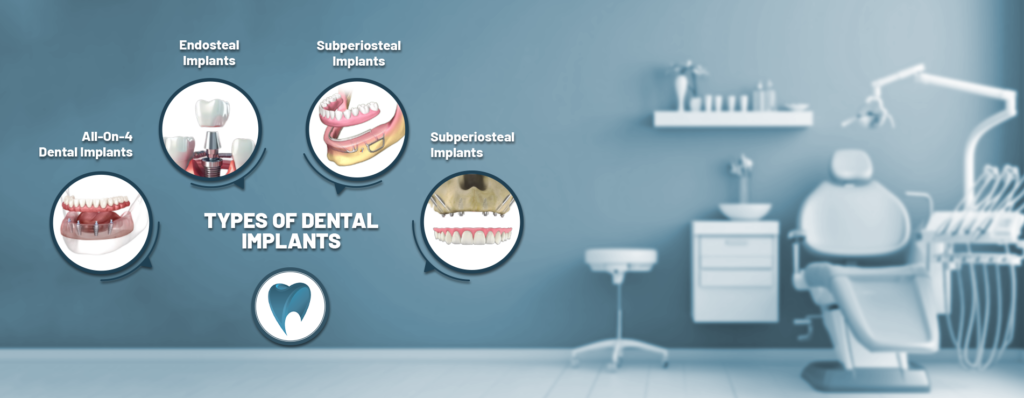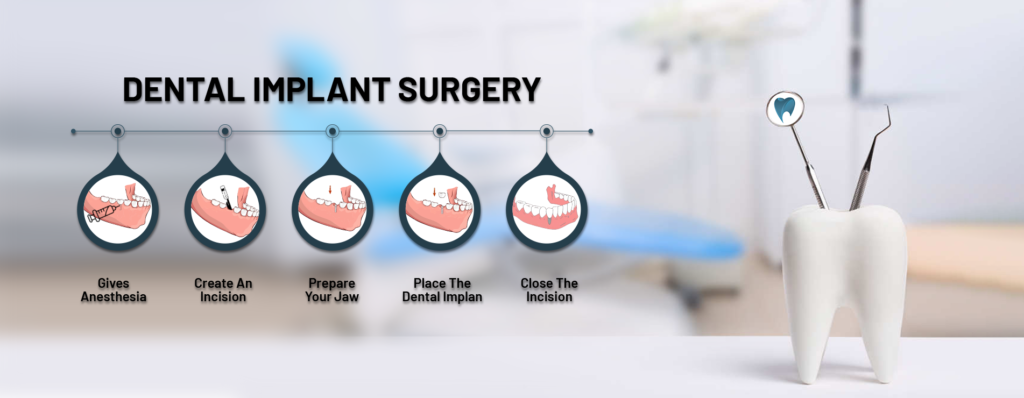What Are Dental Implants?
Dental implants are the most popular and ideal solution for replacing missing or lost teeth. It is a surgical component that interferes with the jawbone to support artificial teeth.
These implants are considered the standard option for replacing missing or lost teeth, providing stability and a long-lasting foundation. It closely mimics the look, feel, and function of natural teeth.
These implants were first introduced in the 1960s and have since become increasingly popular as an alternative to traditional denture removal.
They are generally made up of Titanium, a metal compatible with body tissues, and it can bond with adjacent bones.
In recent years, zirconia has been used, which is white rather than metallic and has similar bone-bonding qualities, making it as effective as Titanium.
Types Of Dental Implants

There are generally four types of dentistry implants that replace missing or lost teeth:
Endosteal Implants
It is one of the most common type of dental implants, which is placed directly into the jawbone. These implants are typically small screws, cylinders, or blades made of biocompatible Titanium. People with adequate bone density should be placed directly into the jawbone.
They are surgically inserted into the jawbone and allowed to fuse with the bone before the artificial tooth is attached. They can easily support single crowns, bridges, and dentures.
Subperiosteal Implants
It is placed on or above the jawbone but beneath the gums. They consist of a custom-made metal framework with posts that protrude through the gum to hold the prosthetic teeth.
The implant framework is custom-made to fit over the jawbone and under the gum tissue. It is sufficient for patients with insufficient bone mass to support endosteal implants, as well as those who wish to avoid bone grafting.
Zygoma Implants
These are the least common and most complex, which are anchored in the cheekbone (Zygoma) instead of the jawbone. It is designed for people with severe bone loss in the upper jaw and as an alternative to traditional tooth implants.
The standard implant is placed into the zygomatic bone, providing a strong foundation for prosthetic teeth. It eliminates the need for a lengthy and strong bone grafting procedure, resulting in a more stable and long-lasting restoration.
All-On-4 Dental Implants
- It is a modern and advanced dental restoration technique designed for patients who have lost almost all or all of their teeth. This procedure involves placing a full arch of four dentistry implants into the jawbone to support replacement teeth.
- A fixed bridge typically contains 10 – 14 teeth. In most cases, bone grafting is not required, even if there is inadequate bone density. These implants are placed in areas with higher bone density.
Recommendations For Patients
Discuss with your dentist about the benefits and potential risks:
Things to consider while having dental implants –
- Your overall health is a crucial factor in determining if you are a good candidate for dental implants.
- Ask your dentist about the brand of dental implants that will be used in your procedure, and keep the information in your records.
- It may take several months or longer to heal, and during this time, a temporary abutment will be placed to support the tooth.
- Follow the oral hygiene instructions, and clean the dental implant and surroundings regularly for the long-term success of the implant.
- The healing process may be affected by smoking, which can minimize the success rate.
- If your implant is painful or feels loose, please notify your dentist immediately.
Procedure Of Dental Implant
A metallic structure is used to replace a missing or lost tooth. With screw-like devices, the transplant is inserted into the jawbone, which acts as an anchor for the artificial tooth.
It is a personalized process that differs for each individual, but the following provides a general overview of what you can expect from your dentist.
Dental implants typically require multiple procedures to complete and may take several months to heal. However, once an implant has healed, it looks and functions like a natural tooth. With proper care, maintenance, and oral hygiene, your implants can last a lifetime.
Dental Implant Surgery

The process of dental implants includes several carefully planned steps.
-
Anesthesia –
Initially, Anesthesia will be administered to numb your gums and induce insensitivity to pain. You can also choose sedation that helps reduce anxiety and nervousness and control pain during the treatment.
-
Incision And Bone Exposure –
A surgeon will make a small incision (cut) in the gums and expose the bone underneath to insert the implant in place.
-
Jaw Preparation –
A small hole will be drilled in the jawbone to widen its opening and fix the new implants.
-
Dental Implant Placement –
Implants will be carefully placed and fixed into your jaw.
-
Closing Of Incision –
Your surgeon may reposition your gums and close the opening carefully with stitches.
If your implants are in the front of your mouth, a temporary tooth will be placed to enhance your look. You probably don’t need a temporary tooth implant if it is not visible from the outside.
Healing Phase
During the healing phase, your gums fuse to the implant, a process known as osseointegration, which is crucial for long-term success.
- The soft tissues begin to heal within the first few weeks, followed by a crucial process of osseointegration.
- This process takes 3 to 6 months.
Placement of abutment and final restoration
Once the healing process or osseointegration is complete, a minor surgery will be performed to attach the abutment. It will be the final restoration, such as a crown, bridge, or denture, to ensure a functional and aesthetically pleasing result.
Benefits Of Dental Implants
Here are the benefits of having dental implant surgery:
- Restores the ability to chew
- Helps keep adjacent teeth stable
- Preserves the health of bone and gums
- Improves quality of life
- Keeps your jawbone from shrinking caused by bone loss
- Ensures cosmetic appearance, providing a confident and pleasing smile
Conclusion
Dental implant systems are made of materials that follow the gold standards of the International Organization for Standardization (ISO).
They have the details about what makes a material safe to use. Nowadays, most dental implants equipment is made of titanium or zirconium oxide, which possesses bone-bonding qualities.
“We Aim To Give You Your Dream Smile”
